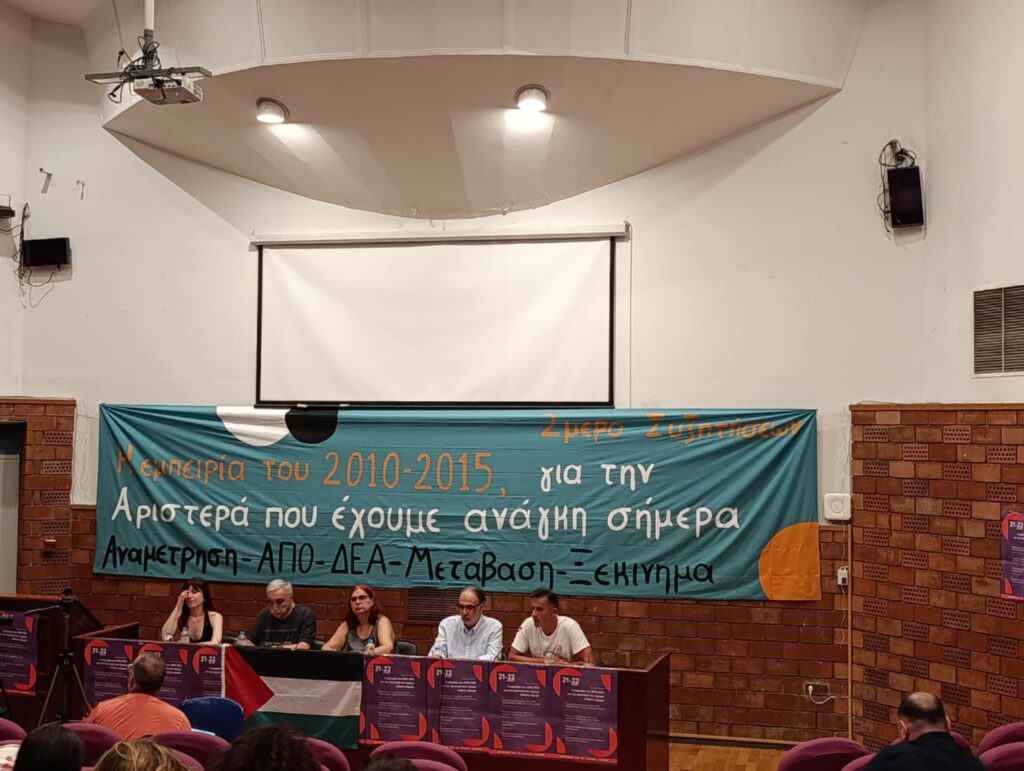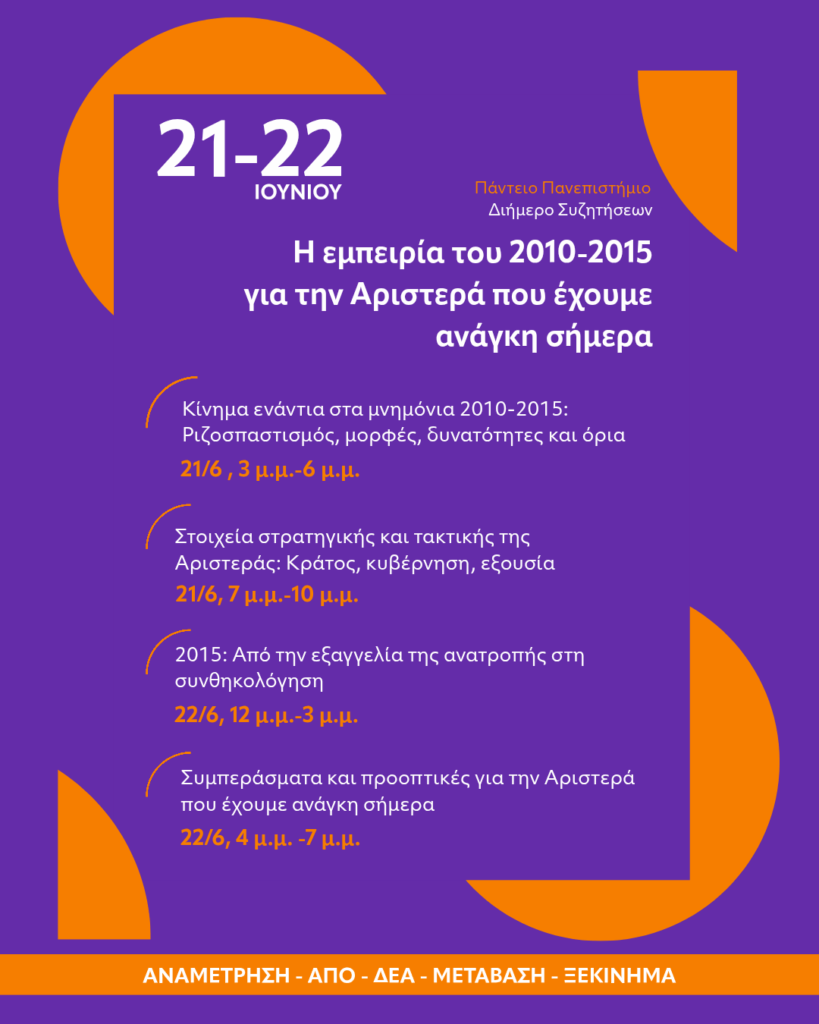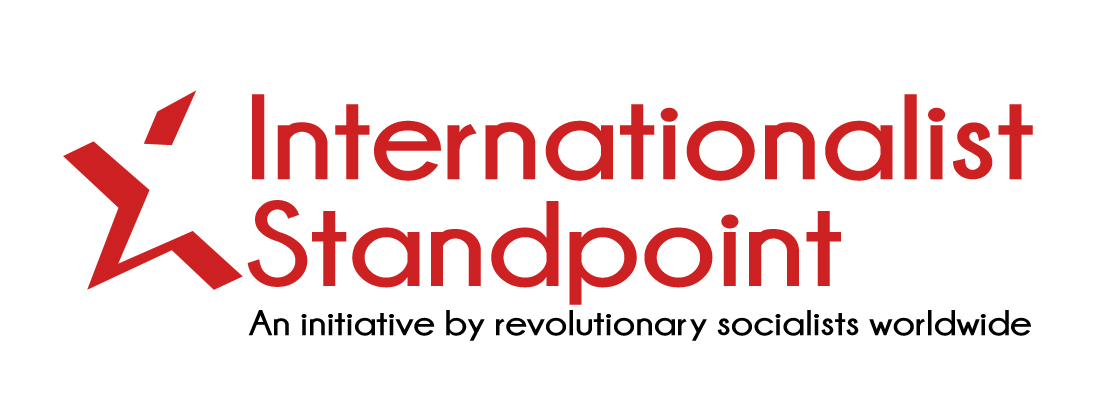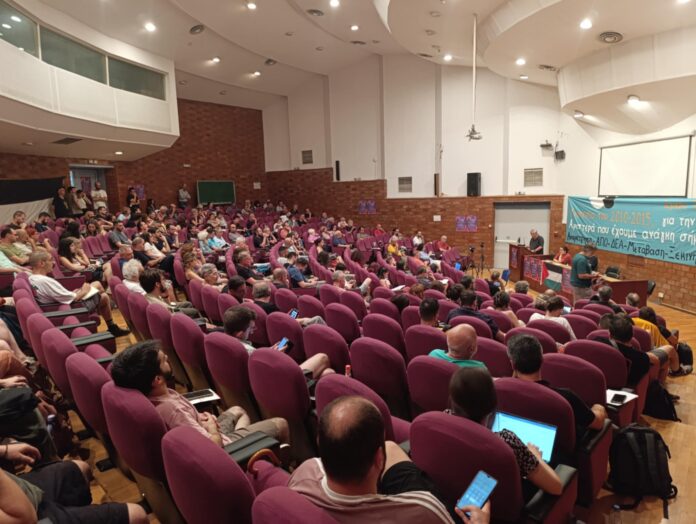In the course of the weekend 21 and 22 of June, five organisations of the Greek anticapitalist Left organised a two-day event in Athens, on the lessons of the period 2010-2015 in Greece.
The four groups, outside Xekinima, the section of Internationalist Standpoint in Greece, were the following:
- Anametrisi, an organization which is the amalgamation of a number of groups that came out of SYRIZA after the 2015 sell-out and out of ANTARSYA (an anticapitalist left alliance in Greece), the ex-youth of SYRIZA being the main constituent force;
- APO (Anticapitalist Political Organisation), of a Trotskyist orientation which was part of the left opposition inside SYRIZA that split off after the summer of 2015;
- DEA (Internationalist Workers’ Left) also an organisation of Trotskyist orientation and part of the left opposition inside SYRIZA until 2015;
- Metavasi, an organisation that was made up of two splits from ANTARSYA. These groups were united by their common perception that a central problem with ANTARSYA was sectarianism and its refusal to apply the “united front” approach to organisations that were not part of the “revolutionary Left”.
Four sessions
The event was divided into four sessions, lasting around 4 hours each. The sessions were the following:
- A discussion on the mass movements that developed in the period of 2010 and 2015 – from the numerous general strikes and sectoral strikes, to the “occupy” movement of Syntagma square, the “no-pay” movement and many other movements of a national or local character, with the struggle against the goldmines in Chalkidiki being the most prominent and determined of the local ones.
- A discussion on the application of the Transitional Programme, the United Front, and the Strategy that were required by the forces of the Left, in this period, in order for the mass movement to be successful in its struggle against the Troika (European Union, European Central Bank and IMF) and the Greek ruling class.
- A discussion on the events of 2015 themselves: the election of SYRIZA in January; the heroic response of the Greek working class in the Referendum of July 5, 2015 (with the banks closed down by the Troika and a terror campaign about “imminent apocalypse”) with 61.31% voting against the Troika’s demands; and then the shameless capitulation of renegade Tsipras – who, in reality, called the referendum with the aim of losing the vote.
- Last but not least, a discussion on the next steps by the “5” in the direction of building a new anticapitalist/revolutionary left pole in the Greek Left.
Maturing over time
The necessity of a new pole of the anticapitalist Left, in the context of the huge vacuum of the Left that exists (in Greece and also internationally) has been maturing over time. [Read more on the Greek Left in the recent ISp document on Europe, paragraphs 100-102 and 142-143]
Xekinima raised this proposal, for the first time in a very concrete way, by appealing to specific organisations in its public material, back in 2023.
As was shown later, other organisations, like APO, DEA and Metavasi were beginning to think in a similar direction.
2023 was a year in which two important elections took place – a general election in the spring of 2023 and local elections in the autumn of the same year.
2023 general election
In the general elections of May 2023 and the runoff in June 2023, Xekinima took a position of calling for a vote to the Left, in general, i.e., without specifying any party of the Left. In practice, the proposal was for a vote to either KKE, the communist party, or MERA-25, the Greek part of Diem25 lead by Varoufakis, or ANTARSYA, the main alliance of anticapitalist organisations.
What however was one of the most interesting elements in these elections was that Xekinima was only one of 7 anticapitalist organisations that took the same position in those elections – i.e., called for a vote to the left parties in general, without specifying any party in particular. This was something that was happening for the first time ever.
Xekinima responded to this event by raising the idea that this common position was not accidental, on the contrary it was very important; that it reflected an advanced understanding on the part of all 7 organisations about the vacuum on the Left and the limitations of the existing left parties. And that it was necessary for these organisations to meet and discuss how they envisaged the future of the Left in Greece.
2023 local elections
The local elections of the autumn of 2023 gave a further impetus to this idea.
In these elections the broad anticapitalist Left was forced to collaborate and form joint lists in a number of municipalities, because of a new law by the New Democracy (right wing) government that imposed a threshold of 3% in order for any list to elect any representatives. It was a conscious attempt to keep small left organisations out of the local councils. Combined with this measure, was the condition that the local election lists should be made up of many tens of candidates (on a municipality and a ward level, together) reaching more than 150 candidates for the biggest municipalities like Athens and Thessaloniki. This was something impossible for the size of the different organisations of the anticapitalist Left.
The results of this “forced collaboration” of the anticapitalist Left were astonishing! Over 6% in Athens, nearly 6% in Thessaloniki, up to 9% in Sykies, another municipality in greater Thessaloniki, and not less than 4.5% in any one of the 15 constituencies where the anticapitalist Left stood together. These results represented, potentially, a real breakthrough for the anticapitalist Left.
Xekinima snatched upon these results to bring forward the huge opportunities that existed if the anticapitalist organisations were willing to work together, in a “united front” manner.
A sign of the times
In a number of articles Xekinima raised the need for a new pole in the anticapitalist Left, with a genuine transitional programme (demands that raise the necessity for revolutionary change) and a clear understanding of the need to apply the methods of the United Front towards the rest of the Left (meaning, KKE, ANTARSYA and MERA25). Xekinima went as far as naming the organisations that could take part in this initiative.
Xekinima’s positions were a sign of the times. As mentioned above, other organisations, like DEA, Metavasi and APO, were beginning to think in similar terms.
A number of public meetings were organised where ideas were exchanged about the vacuum in the Left and how to go forward. Bilateral meetings also took place between different organisations to get a better feel of the situation.
In the beginning of 2025, the 5 organisations met between themselves (some other groups were also present but are not ready to commit themselves, at least as yet) and began to plan concrete steps. These included joint contingents on some demonstrations, producing common public statements, and organising joint public meetings. The June 21-22 event was the most important of the various initiatives that took place in this period.

A balance sheet of June 21-22
The June 21-22 meeting was important in showing the extensive convergence that exists as regards analysis, perspectives and strategy. It was also important in strengthening relations between the 5 organisations.
The platform was open to other forces of the Left, apart from the organisers. Thus, there were speakers from different wings of ANTARSYA, MERA 25 and from the ex-left opposition of SYRIZA (which after 2015 split into numerous segments) invited to speak. Several other organisations which are following the initiative of the 5 were also present and are positive about collaboration but are not ready at this stage to commit themselves to the political aims of the “five”. Such organisations are Diktyo (a network of activists centering mainly on antiracist initiatives), KEMA (one of the many splits from “Popular Unity”, the main left alliance that split from SYRIZA in 2015) and the “Pirates” party (a small radical youth grouping).
Linking their positions to the experiences of 2010-15, all 5 organisations have committed to the need for a revolutionary change of society – rejecting reformism and the idea that there can be a a gradual, parliamentary way to “change” capitalism and the EU. They are advocates of the Transitional Programme and the United Front. They agree on the central role of the working class as the agent of revolutionary change and have a consistent attitude of immersing themselves into mass movements, nationally and locally. They all have an internationalist perspective, in the sense that they understand that the struggle against the system needs to have an international dimension – that it is not possible to be victorious just on the national level.
Over the past months the 5 organisations have published joint statements on current political issues like the Tempi train crash, the need to nationalize the railways and the commanding heights of the economy, stressing the need of workers’ control and management, on Palestine, etc.
Of course, it would be naïve to expect agreement on everything. These organisations come from very different traditions and backgrounds, but it is clear that they all studied the experiences of the mass movements and the Left in the period after 2010 and have drawn similar conclusions.
There is respect for the independence of each and every organisation, so no demands of liquidation are posed. It is agreed that consensus will play a major role in decision-making processes, and every organisation will be free to publish its own material on any issue they think is necessary. There is also a very positive and comradely mood in the meetings and the discussions – all of these organisations have experienced the toxic factional atmosphere inside SYRIZA, ANTARSYA, and the Greek Left in general, and reject it.
There are many issues that still need to be clarified. Some are political, for example, on imperialism and the national question, or our attitude to electoral alliances. Others are organisational, such as what is the structure that will best guarantee democratic rights to the constituent organisations but also to workers and youth who want to join the common initiative as individuals, or what kind of campaigns we should focus on in the next period.
So, nothing is yet guaranteed but a clearly positive step is taking place. It is not entirely certain that a new political formation will be the result of these efforts. If that proves not to be possible in the next period, there is, however, definitely going to be a close collaboration between a number of organisations based on the united front approach, with joint interventions in society on a multiplicity of issues. This will send a strong message to the Greek working class and social movements: that we are against sectarianism and for joint struggle against the attacks we face, in support of the demands of the working class and the social movements and against the system of profit and barbarism.
During the coming days, we will publish the main interventions by Xekinima




